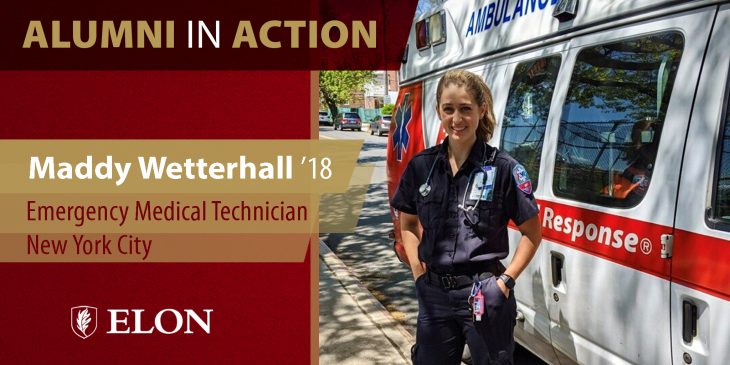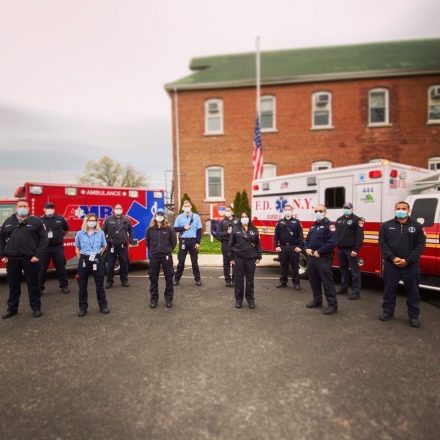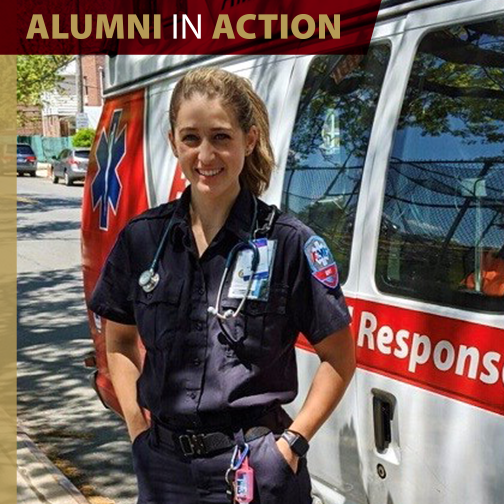The EMT worked in Atlanta running 9-1-1 calls since January of this year, but heeded the call to leave her home to go to the Big Apple and work through FEMA to help where she was needed most.
 Imagine volunteering to live and work in the epicenter of an extremely dangerous and contagious virus for anywhere from three to 30 days. Imagine those 30 days turned into 50 with only two days to rest. Imagine only being in your EMT role for a few months before heading to the hot zone.
Imagine volunteering to live and work in the epicenter of an extremely dangerous and contagious virus for anywhere from three to 30 days. Imagine those 30 days turned into 50 with only two days to rest. Imagine only being in your EMT role for a few months before heading to the hot zone.
This is Maddy Wetterhall’s story. She describes in vivid detail what daily life was like for an EMT in New York City during the height of the pandemic. She shares behind the scenes experiences including the split second, lifesaving decisions she had to make by trusting her instincts and training.
How did you end up deployed to NYC? How did you feel about it?
My company’s Office of Emergency Management asked for volunteers for people who were able to be deployed with FEMA, and I signed up. As a new EMT, I was shocked when I was selected to go, but I was excited about the opportunity. We were given a list of all the items to pack that we could possibly need in the first 72 hours of deployment, and told we would possibly be deployed for up to 30 days.
We had no idea what to expect — we didn’t know if we would be flown up or drive up, if we would be living out of our ambulances, and didn’t know what our role would look like up there. We knew we were going into the hot zone of an incredibly contagious virus. We knew it was dangerous and something that we could possibly die from, but as emergency medical care providers, this is what we do. We overlook that fear and go into emergency situations and try to help in any way that we possibly can.
What did you experience while working in NYC? How did it compare to Atlanta?
When we got to NYC, we were informed that the city’s 9-1-1 system was overwhelmed. 9-1-1 call volume was double what it normally is, resulting in wait times of eight hours or more, which is a long time to be waiting for a response when someone calls 9-1-1.
We were partnered up, separated into different task forces, and sent to different boroughs to run 9-1-1 calls there. We averaged 16-hour days, and in my 50 days up there, only had two days off. The types of calls we ran varied any given day. We had a lot of patients with COVID-19 symptoms, but the regular 9-1-1 calls (cardiac arrests, traumas, chest pain, strokes, overdoses, etc) didn’t stop because of the pandemic. In EMS, usually 90 percent of calls are noncritical and 10 percent are critical. In the state of emergency that New York was in, that statistic was flipped, and we could definitely feel that on the ground.
 During my first few weeks there, hospitals were overcrowded and overwhelmed. Critical patients who were intubated were in hall beds because there just wasn’t space. Refrigerator trucks were lined up outside and filling up within a few hours. In one hospital in Queens, I felt like I was like playing Tetris with stretchers of critically-ill individuals, just trying to get to my patient. It truly was like a war scene.
During my first few weeks there, hospitals were overcrowded and overwhelmed. Critical patients who were intubated were in hall beds because there just wasn’t space. Refrigerator trucks were lined up outside and filling up within a few hours. In one hospital in Queens, I felt like I was like playing Tetris with stretchers of critically-ill individuals, just trying to get to my patient. It truly was like a war scene.
Many of the people who called 9-1-1 were scared to go to the hospital. Some waited too long to call just out of fear that they would have to go.
By the end of my 50 days there, hospitals started looking much better, and call volume was much closer to normal levels. It was really fulfilling to see the progress and know that our efforts had helped.
I would say Atlanta is the diet version of NYC. Any given day in Atlanta, you might run one or two memorable calls. In NYC, I would say it was more like four or five. Here is a brief description of two of the many memorable calls we ran:
- My partner and I responded to an elderly man who was in dire need of dialysis, but couldn’t get to his dialysis clinic because he was bedridden and the service that normally transports him was overwhelmed. My partner and I knew that taking him to the hospital could mean a death sentence for him, but not doing anything could, too. As a 9-1-1 ambulance, we can only take patients to emergency departments, not to other healthcare facilities. As a solution, we ended up carrying him down five flights of stairs and putting him in a taxi with his daughter so that he could get the help he needed while also reducing his risk of exposure.
- The first time I ever started running a cardiac arrest took place in the middle of traffic directly across from the hospital entrance. The patient drove himself to the hospital, parked out front and then went into cardiac arrest. It was overwhelming how seamlessly and professionally two out-of-town ambulance crews, NYPD officers, and a team of doctors and nurses from the hospital worked together towards one common goal in the middle of the roadway surrounded by traffic and onlookers.
 Atlanta spoils us with electronic stretchers and stair chairs with tracks, and by nature of the city’s younger age and newer buildings, there’s pretty much always an elevator. New York City is an entirely different beast. Everything is manual (stair chair, stretcher, vitals). Only buildings over six stories high are required to have elevators, and even if they had an elevator, it was always a gamble as to whether or not the stretcher would fit. We once had to carry a stretcher down five flights of stairs because the elevator broke while we were tending to our patient!
Atlanta spoils us with electronic stretchers and stair chairs with tracks, and by nature of the city’s younger age and newer buildings, there’s pretty much always an elevator. New York City is an entirely different beast. Everything is manual (stair chair, stretcher, vitals). Only buildings over six stories high are required to have elevators, and even if they had an elevator, it was always a gamble as to whether or not the stretcher would fit. We once had to carry a stretcher down five flights of stairs because the elevator broke while we were tending to our patient!
What have you learned about yourself or your community during the pandemic? How has your perspective changed with regard to your future and career?
I became an EMT because I wanted to have the opportunity to gain meaningful patient contact experience while also getting the chance to help people in the community where I grew up. In Atlanta, I work under a paramedic. In NYC, I was challenged every day to think on my own without a paramedic there to look over my shoulder. I learned to trust my instincts and my training and have become a more confident provider. The entire experience has confirmed to me that I am in the right field and that I want to continue to help people in their time of need.
What brings you hope or joy in these uncertain times?
It is such an honor and privilege to take part in some of the most intimate moments in my patients and their families’ lives. It brings me joy to know that I have helped, if even only a little, to make their day a little brighter. Additionally, I couldn’t have done any of this without the outpouring of support shown to us by the NYC community, FDNY, and all of our loved ones back home.



